ROY: a consideration in comics
STOP!
Before reading these notes, you may want to order a physical copy of Roy from the shop for the full experience (HERE). No? Well, you can see the pages below and imagine them printed at A5 on newsprint…
WHY NEWSPRINT?
Roy Lichtenstein appropriated what he considered debased source material from pulp and newsprint origins and blew them up in the process of transposing them to an exalted medium. And then selling them at deluxe prices.
With Roy, I’ve appropriated images from the 20th century high art canon and reduced and translated them to a debased medium. They are now given away freely online or sold at a budget price. Please pass it on and extend the discussion.
WHY DOES THIS EXIST?
Roy Lichtenstein is the most visible/successful exponent of a practice that copies the work of less celebrated artists and claims it as their own with no comment on or attribution to the originals.
The argument for this is that in re-presenting these images in a new context (usually at a much different scale) they are transformed by the appropriator’s effort/intent/reputation from not-art to art.
The argument against this practice is that it is plagiarism and deceit (even when portions of an image are redrawn, such extensive referencing of another’s work reduces the number of compositional/aesthetic choices to a craft) ~ making art into fake-art.
The arguments against are often passionate and, in terms of art theory, incoherent. The arguments for tend to be elitist and obscured by lack of awareness of the source material.
For years I sat on the fence ~ and, if anything, mentally divorced the appropriated art from its source. But recently I have made a series of paintings and drawings that refer back to published illustrations and comics and in deciding what I do and why, I’ve had to re-examine my thinking on Lichtenstein and his derivatives.
My judgement (as of summer 2012 at least) follows this breakdown of Roy ~ A Consideration in Comics.
THIS IS WHAT I MADE
A pamphlet of drawings derived from paintings which were derived from drawings in comics.
Reversing the procedure wherein Lichtenstein took comics panels and enlarged them using a dehumanising mechanical line, the images in Roy take paintings and compress them with a very human, idiosyncratic brushstroke.
The provenance of my images is further confused, because ~ of course ~ I didn’t redraw Roy Lichtenstein’s paintings. I redrew images from printed books with representations of Roy Lichtenstein paintings in them.
Where Lichtenstein changed text and minor visual elements from the comics to focus on the banal, I change similar elements in the paintings to comment on their relationship (and that of their audience/curators) with the original illustrations (and their audience/creators).
In contrast to the paintings, but in keeping with my true source material (the books about the paintings), these notes incorporate full attribution as well as expanding on the many allusions/asides hidden in the text.
Images and text in black are my drawings and rewritings commenting on different works by Roy Lichtenstein ~ they are not always appropriated from the same painting.
Texts in grey are actual Roy Lichtenstein quotes from interviews and articles, presented as contrast without any editing. Consistent with Lichtenstein’s practice of not crediting the commercial artists or their publishers he took from, these are not attributed.
Black texts on grey boxes are part of my own commentary.
The text in the captions is, naturally, set in Comic Sans!
COVER
appropriating Self-Portrait, 1978. from LICHTENSTEIN – Janis Hendrickson, Taschen 2001, p78
ARE WE ON A FIRST NAME BASIS, THEN?
Well, I called this Roy because it’s about a perceived Roy Lichtenstein not a real person ~ much as Lichtenstein’s comics-based paintings use a fabricated character called Brad. Besides, Roy Lichtenstein never namechecked any cartoonists so I’m not dropping his name in my comic! Nyah!
WHY A CONSIDERATION?
According to the dictionary in my head one definition of a consideration is: payment given in exchange for a service rendered. Recompense.
Roy Lichtenstein never seemed to consider the people behind his source material and certainly they did not receive payment for their unwitting-but-essential contribution to his success.
WHO IS B. H. DAY?
The dots in Roy Lichtenstein comics paintings mimic the industrial halftone process commonly referred to as Ben Day Dots developed by printer Benjamin Henry Day in 1878.
By the time I used graphics materials in the UK we had Letratone ~ but to use that as a nom de plume I’d have to be writing poetry!
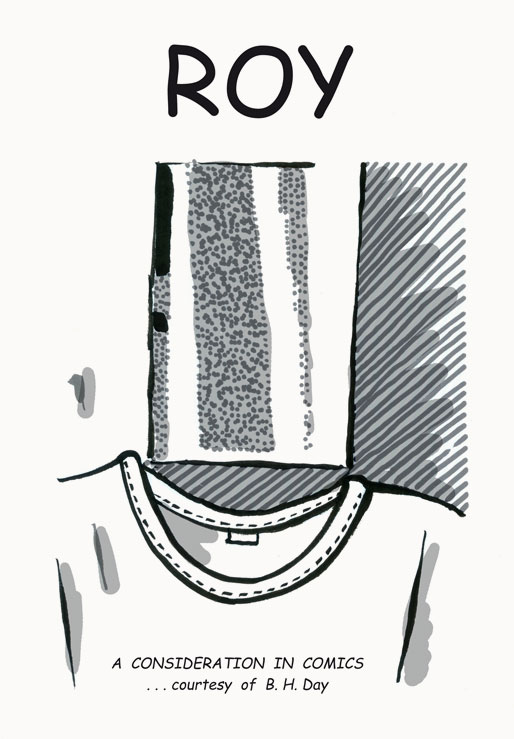
PAGES 2/3
appropriating Mad Scientist, 1963. from LICHTENSTEIN – Janis Hendrickson, Taschen 2001, p32. Bratatat!, 1963. from IMAGE DUPLICATOR: Roy Lichtenstein and the emergence of Pop Art – Michael Lobel, Yale University Press 2002, p9
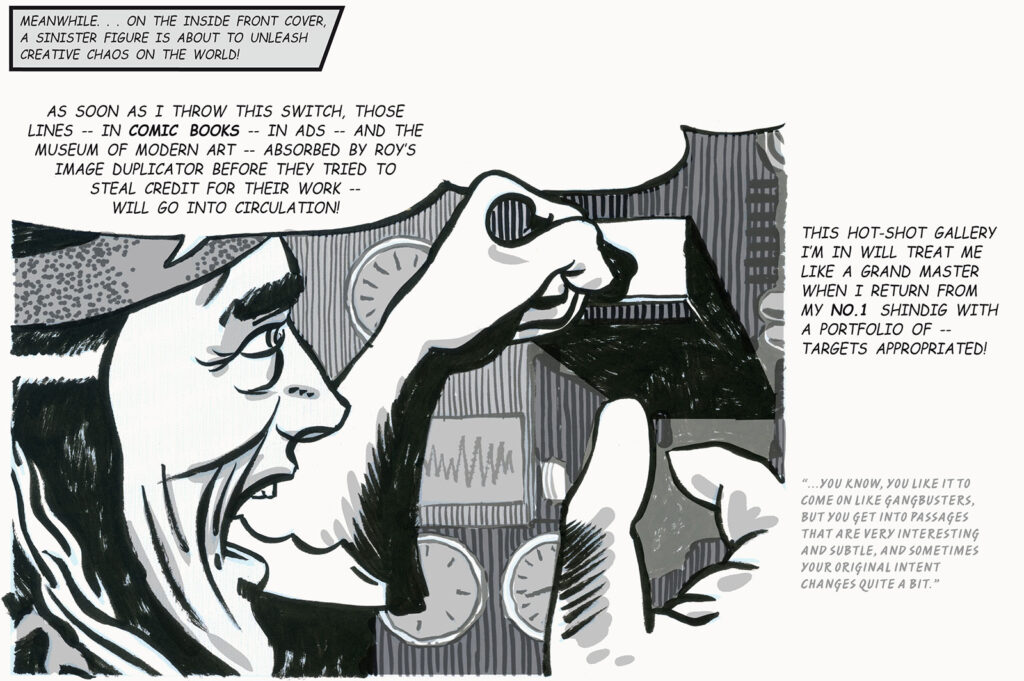
“MEANWHILE…”
THE quintessential comic book cliché word leads us into this look at a slightly-above average American painter who struck gold with an idea that he ran with for many, many years.
In the process of milking this idea, Lichtenstein consistently failed to credit the artists he copied ~ largely because they worked in a medium he did not value – which qualifies him as a SINISTER FIGURE in my book. (literally).
The idea of re-presenting previously-drawn objects as standalone works by a new hand certainly unleashed CREATIVE CHAOS on the world.
Duchamp’s ready-mades were a case of showing an everyday object in a different light and questioning aesthetics in the process. Appropriating one artist’s work with minimal changes beyond cropping and scale was more akin to the conceptual art of the 21st century that works fine as concepts but makes low-grade art when actually executed.
INTO CIRCULATION?
Lichtenstein became such a large commercial success while (apparently) requiring little artistic skill or thought made ‘his’ work more copied and referenced than the comics he himself copied.
This muddying of the understanding of authorship is emphasised by the fact that The Roy Lichtenstein Foundation recently dropped their prospective legal action for copyright infringement against the band Elsinore whose album cover featured a redrawn comic book panel that Lichtenstein had previously appropriated ~ that is, they had used the same source not copied a work by Roy Lichtenstein.
Lichtenstein became a ubiquitous style separate from the artist or his source material and circulated around the world selling everything from dating agencies to car tyres to pizza.
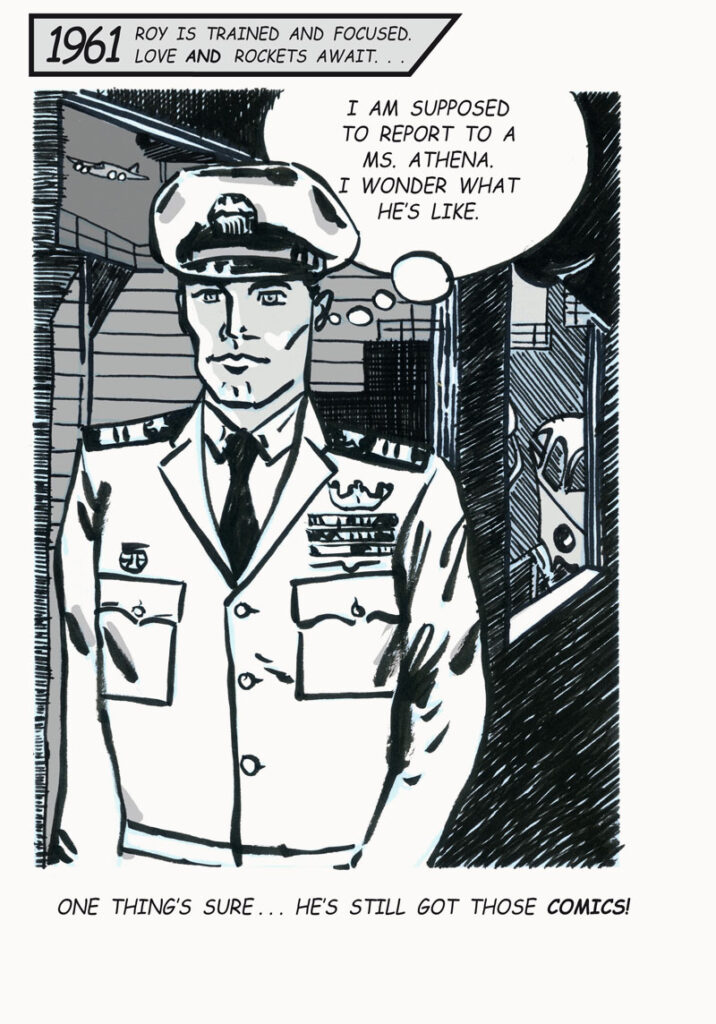
PAGE 4
appropriating Mr. Bellamy, 1961 from LICHTENSTEIN – Janis Hendrickson, Taschen 2001, p12. Emeralds, 1961 from IMAGE DUPLICATOR: Roy Lichtenstein and the emergence of Pop Art – Michael Lobel, Yale University Press 2002, p97
1961
Roy Lichtenstein trained as a fine artist and began showing derivative abstract expressionist paintings with little success until he started playing with comic images and was surely surprised by the positive responses he was getting. Having trained at art school under Hoyt Sherman, he now trained his eye on an unexpected commercial opportunity.
‘FOCUSED’ also refers to his practice of using a projector to enlarge his sketches of comic panels for painting ~ he focused them on to a wall.
Lichtenstein became celebrated and reviled in equal measure for his art-from-comics series but the phrase LOVE AND ROCKETS also refers to the preeminent comics-as-art title of the 20th Century.
MS ATHENA
Roy Lichtenstein and Lichtenstein-styled product have been a mainstay of poster, card and gift shops such as Athena.
Athena is also, of course, the goddess of wisdom, so confusing the gender is a reminder that one may be clever and wrong simultaneously.
PAGE 5
appropriating I Know … Brad, 1963 from LICHTENSTEIN – Janis Hendrickson, Taschen 2001, p13
GRANITO-FACED is not a typo. Rob Granito has a long history of passing off comic artists work as his own.
It’s hard to see a distinction between his activities which have brought him nothing but opprobrium and derision and that of Roy Lichtenstein other than through the commentary of critics and salesmen. I certainly reject the theory ~ advanced ad nauseam by Michael Lobel ~ that Lichtenstein made any serious aesthetic choices in his appropriations rather than decisions of convenience or accident.
There is more reading-into his work by critics than any other pop artist and that seems indicative of there being less actually there!
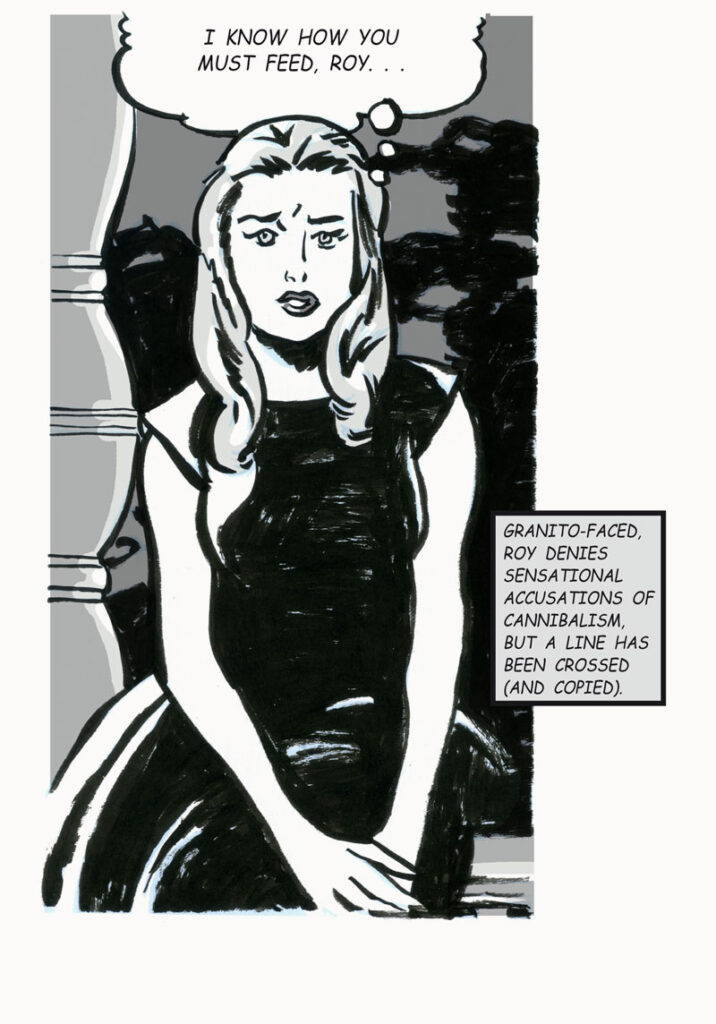
PAGES 6/7
appropriating We rose up slowly, 1964 from LICHTENSTEIN – Janis Hendrickson, Taschen 2001, p10

The highly influential dealer LEO CASTELLI gave Roy Lichtenstein’s comic paintings their first exposure at his 77th Street gallery. As the primary vendor for these works, he was instrumental in the process of making copies of other works commercially and artistically accepted.
He worked closely with Lichtenstein to build up a mythology of the artist and it is hard to imagine he was unaware of the provenance of the pictures… he KNOWS WHERE THE BODIES ARE BURIED…
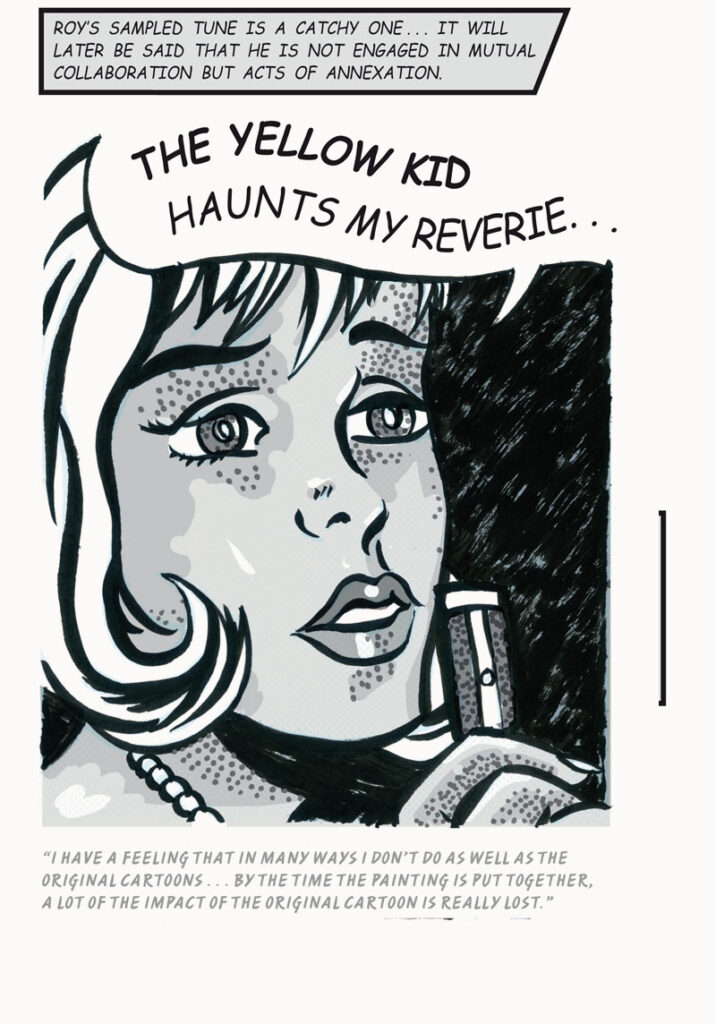
PAGE 8
appropriating The Melody Haunts My Reverie, 1965 from LICHTENSTEIN – Janis Hendrickson, Taschen 2001, p27
THE YELLOW KID has been claimed by many US writers as the original comic strip ~ a claim that has been repeated so often it has seeped into general acceptance despite numerous examples of the form being developed previously. Even the origins of the originals are not clear!
PAGE 9
appropriatingVicky, 1964 from LICHTENSTEIN – Janis Hendrickson, Taschen 2001, p39. As I opened Fire, 1964 from LICHTENSTEIN – Janis Hendrickson, Taschen 2001, p28
“SEKS” is a contraction of Mike Sekowsky’s name, one of the major Romance Comic artists Lichtenstein took from with no attempt to credit (it’s also a soundalike for Lex as in Lex Luthor).
But there is a whole chapter in Michael Lobel’s IMAGE DUPLICATOR hagiography devoted to the idea that Lichtenstein was making very precise gender commentary in ‘his’ compositions. An argument that strikes me as desperately Freudian (seeing SEX everywhere) and wilfully ignoring how little compositional thought the Lichtenstein comic paintings demanded of their author.
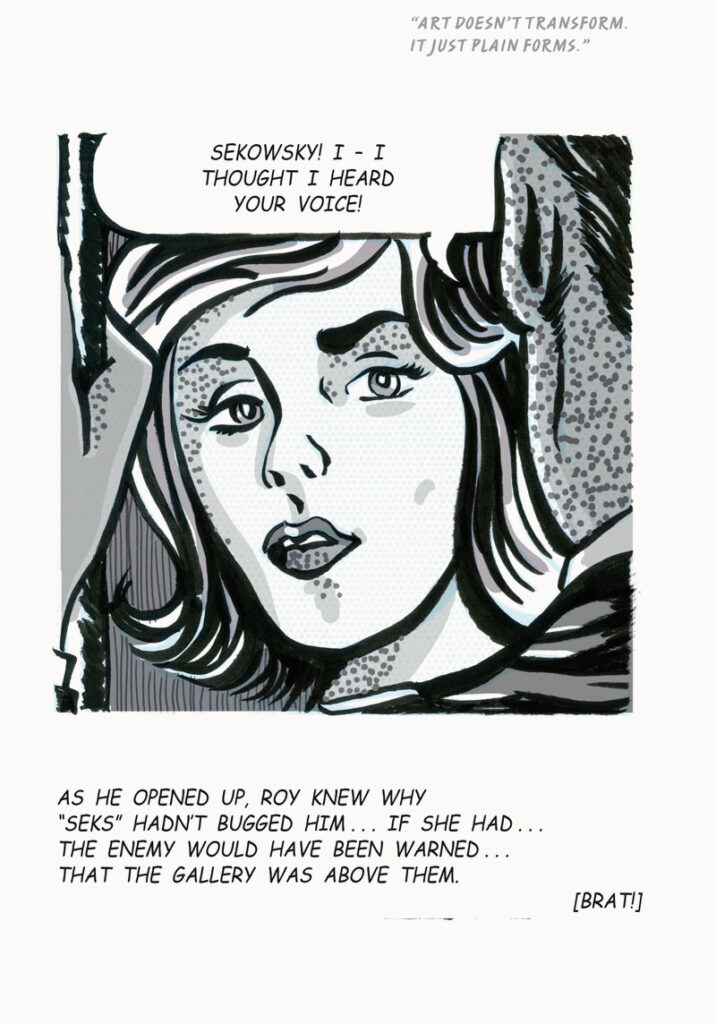
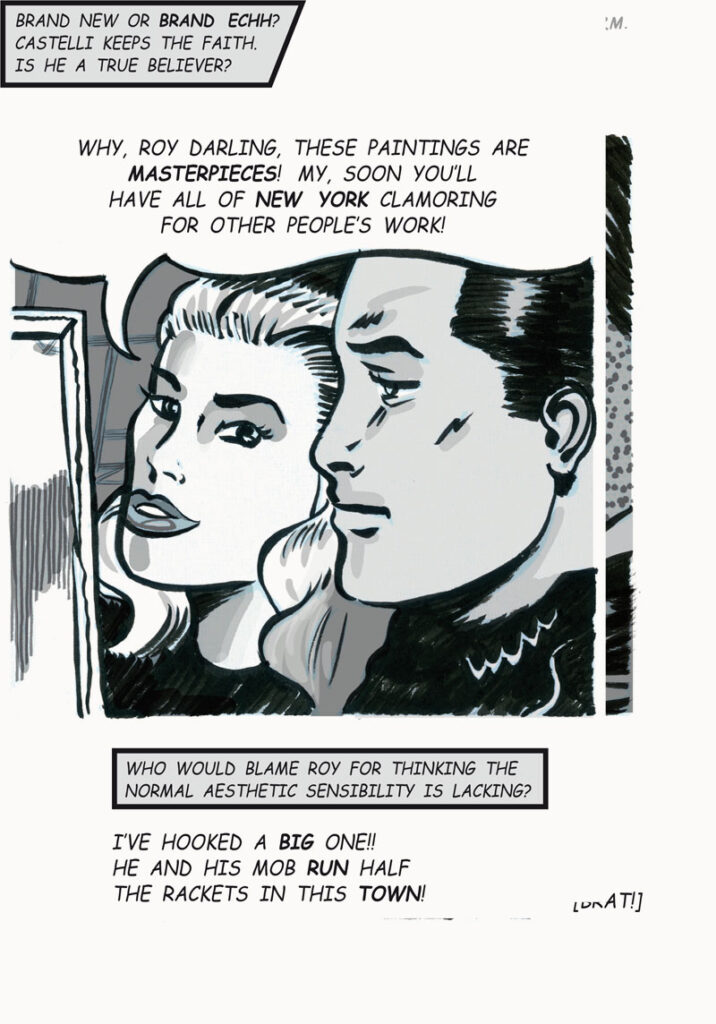
PAGE 10
appropriating Masterpiece, 1978 from LICHTENSTEIN – Janis Hendrickson, Taschen 2001, p14. Artist’s Studio, Look Mickey, 1961 from LICHTENSTEIN – Janis Hendrickson, Taschen 2001, p63
BRAND ECHH, KEEPER OF THE FAITH and TRUE BELIEVER were hyperbolic phrases used by Marvel Comics editor Stan Lee throughout the 1960’s to promote his company’s wares.
PAGE 11
appropriating Eddie Diptych, 1962 from LICHTENSTEIN – Janis Hendrickson, Taschen 2001, p33. Brmattata!, 1962 from IMAGE DUPLICATOR: Roy Lichtenstein and the emergence of Pop Art – Michael Lobel, Yale University Press 2002, p97
‘GHASTLY’ Graham Ingels was one of he leading EC Comics horror artists in the 50’s ~ not exactly a muse for Lichtenstein, but his regularly subject matter of reanimated corpses and robbed-graves is appropriate, I feel.
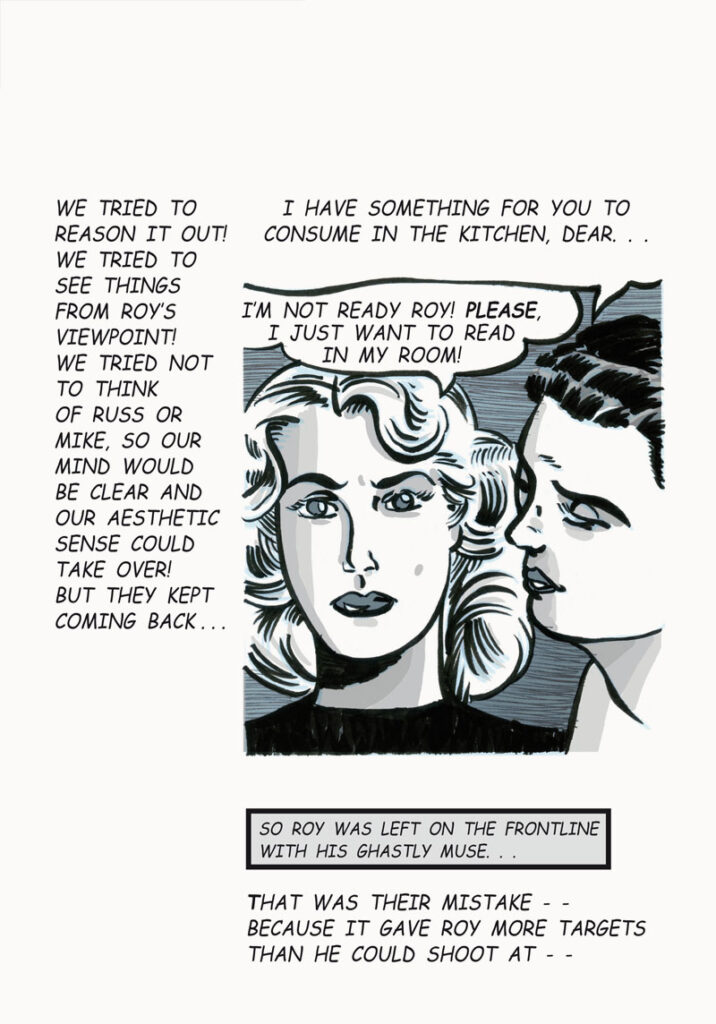
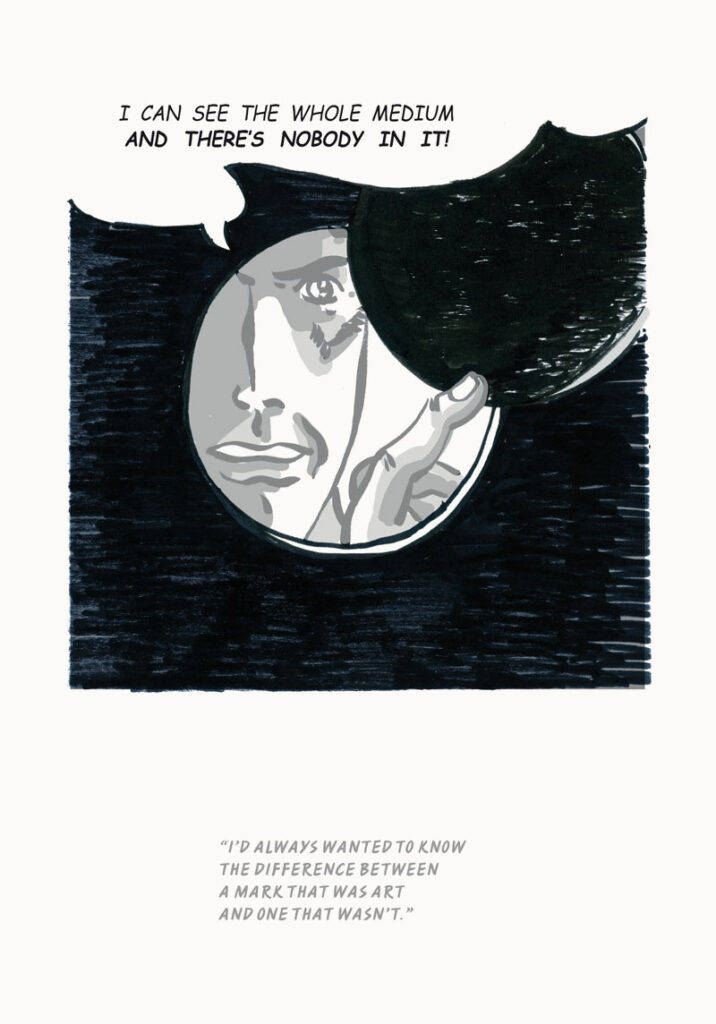
PAGE 12
appropriating I can see the Whole Room and There’s Nobody in It, 1961 from LICHTENSTEIN – Janis Hendrickson, Taschen 2001, p78
PAGE 13
appropriating Torpedo . . .los!, 1963 from LICHTENSTEIN – Janis Hendrickson, Taschen 2001, p20. Whaam, 1963 from LICHTENSTEIN – Janis Hendrickson, Taschen 2001, p22
DAVE TWEETY CHEERS ROY ON AS HE BLOWS THINGS UP . . .
Art critic, David Sylvester was an early champion of Roy Lichtenstein, claiming that the change of scale involved in his process was a key component of making these paintings significant works of art.

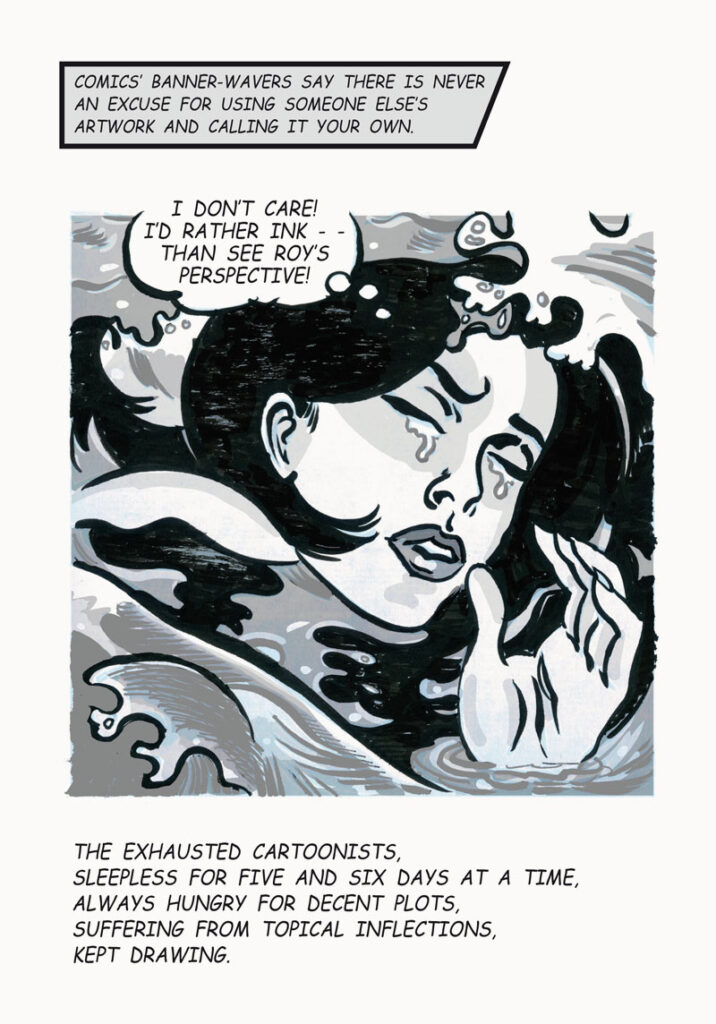
PAGE 14
appropriating Drowning Girl, 1963 from LICHTENSTEIN – Janis Hendrickson, Taschen 2001, p31. Takka Takka, 1962 from LICHTENSTEIN – Janis Hendrickson, Taschen 2001, p23
BANNER-WAVERS
Bruce Banner is the alter-ego of Marvel Comics’ Hulk character ~ a creature of uncontrollable rage, whose tv catchphrase “you wouldn’t like me when I’m angry” is a good fit for the indignant comic fans’ reactions to Roy Lichtenstein (and, yes, the irony of describing a character designed by the legally-fleeced artist Jack Kirby as belonging to the publisher is deliberate).
THERE IS NEVER AN EXCUSE FOR USING SOMEONE ELSE’S ARTWORK AND CALLING IT YOUR OWN
This phrase was lifted from a reader’s comment following an online article about Lichtenstein’s practice ~ as it encapsulates a great number of absolutist opinions on the artist, I have quoted it and called it my own!
PAGE 15
appropriating Two Paintings: Dagwood, 1983 from IMAGE DUPLICATOR: Roy Lichtenstein and the emergence of Pop Art – Michael Lobel, Yale University Press 2002, p2. Okay, Hot-Shot, 1963 from IMAGE DUPLICATOR: Roy Lichtenstein and the emergence of Pop Art – Michael Lobel, Yale University Press 2002, p97
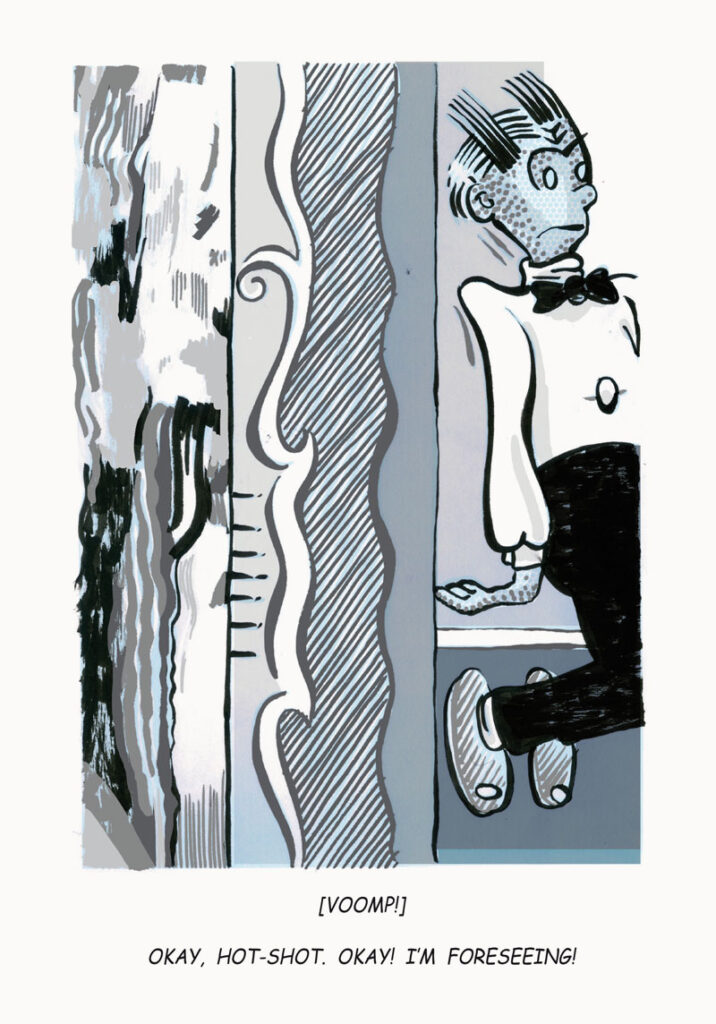

PAGE 16
appropriating Girl with Ball, 1961 from LICHTENSTEIN – Janis Hendrickson, Taschen 2001, p78. The Engagement Ring!, 1961 from IMAGE DUPLICATOR: Roy Lichtenstein and the emergence of Pop Art – Michael Lobel, Yale University Press 2002, p97
PAGE 17
appropriating The Kiss, 1962 from LICHTENSTEIN – Janis Hendrickson, Taschen 2001, p34
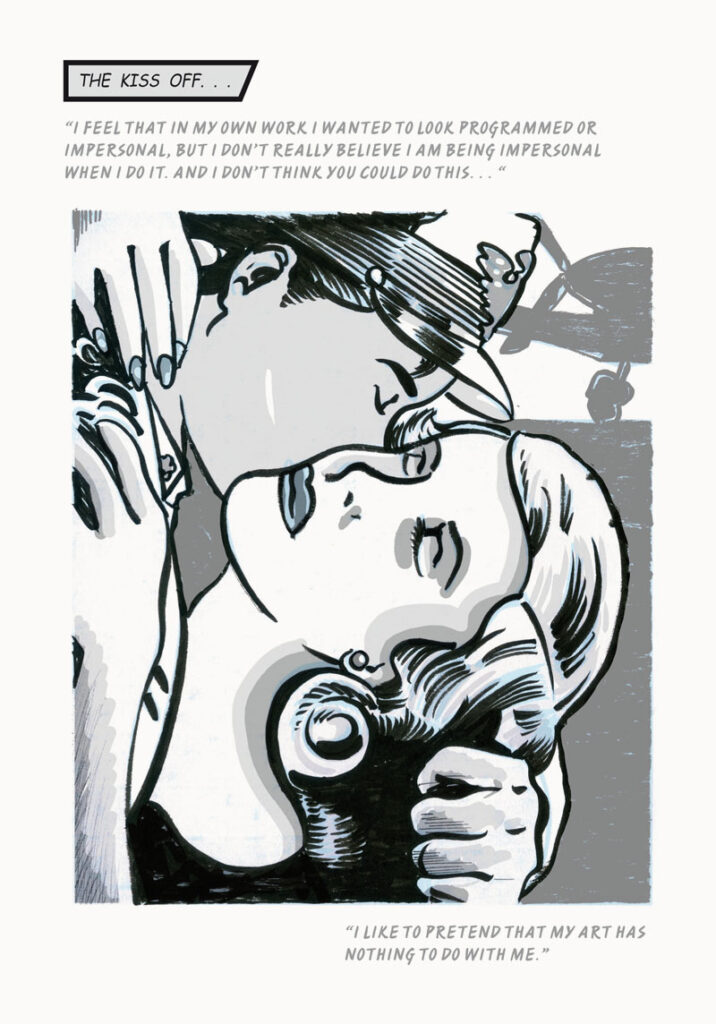
PAGE 18/19
appropriating Mirror in six Panels No. 1, 1970 from LICHTENSTEIN – Janis Hendrickson, Taschen 2001, p77
Because of Lichtenstein’s quote on this spread I have printed my drawing upside down…
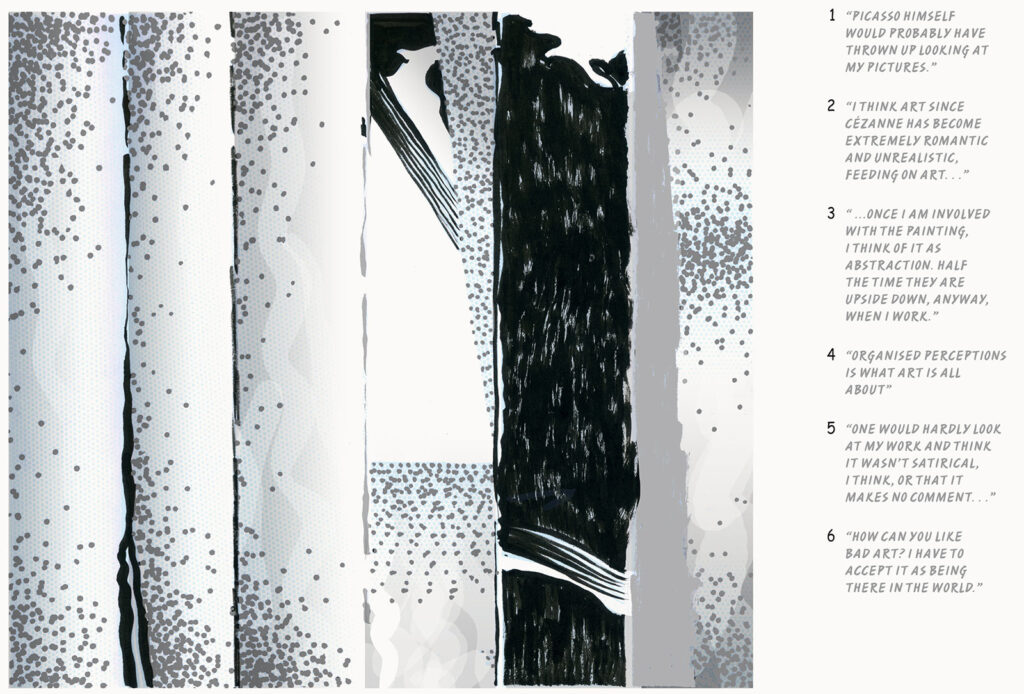
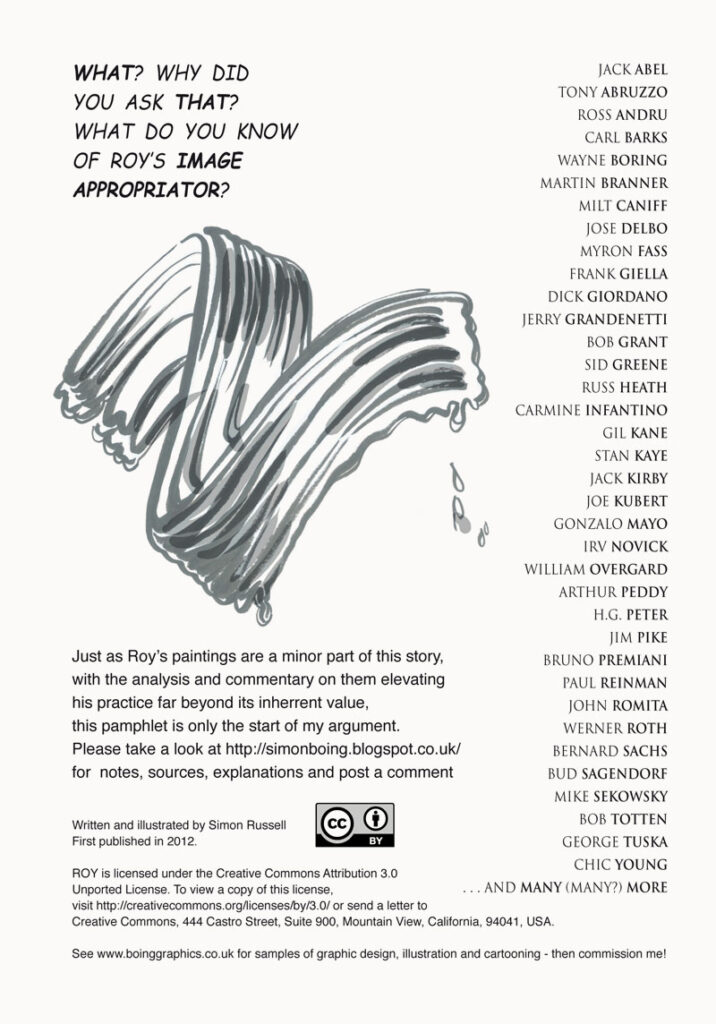
BACK COVER
appropriating White Brushstroke I, 1965 from LICHTENSTEIN – Janis Hendrickson, Taschen 2001, p44
The list of names on the right are all those cartoonists appropriated by Roy Lichtenstein I’ve managed to find attribution for ~ some are the illustrators of absolutely certain source material, others are likely sources based on many scholars’ research.
The uncertainty over who drew the original images and sometimes even which panel or comic was an original source lends some flimsy support to the idea that Lichtenstein was recontextualising a homogenous anonymous set of symbols into something new, but that is largely shoring up critical analysis with arrogance and ignorance.
At this late stage, marrying the pictures to specific comics copied is no easy task as the periodicals were rarely kept in any organised way. But at the time of the paintings’ execution, it would have been a simple matter for Lichtenstein or Castelli to identify each panel appropriated.
Those contemporary comics were usually produced in New York by easily contactable publishers and it would have taken very little effort to identify and credit the original artists.
That 50 years on, so many comics experts have been able to positively identify a large proportion of the source material, puts the lie to the claim that even unsigned these were the mechanical works of anonymous hands.
FURTHER READING
The arguments, such as they are, put forward here are my own but there is much debate available if you want to look further… the following web pages were of particular use to me:
- David Barsalou – Deconstructing Roy Lichtenstein
- The Roy Lichtenstein Foundation
- Tech Dirt on copyright
- Eddie Campbell
- Rian Hughes
- The Comics Journal: Lichtenstein and the Comics in Chicago (radio)
So… even after all that, do you care about my opinion of Roy Lichtenstein and his followers?
The appropriated images are often poorly copied and the majority of them are changed for the worse by the copyist either by choice (evidencing a weak aesthetic) or accident (evidencing a weak technique).To sample existing works so heavily imposes a responsibility on the copyist to acknowledge the source explicitly ~ not to do so is deceitful. Were a painter revealed to take as much from the work of a professional photographer without acknowledgment, they would be pilloried by the critics and shunned by serious dealers.
Sampling other artists’ works so heavily demands the new work should comment on the source material in some way beyond merely suggesting that it exists. The lines and colours mimicked in Roy Lichtenstein’s comic paintings were made through human intervention with specific intent and should not be regarded in the same manner as a piece of fruit in a still life.
Commercial galleries/collectors share much of the blame for this lack of credit ~ their cultural myopia encouraging creative theft from supposedly lesser media and actively discouraging attribution to boost their commercial value and critical credentials.
Merely changing the scale and a few compositional elements in recropping others’ work COULD be a comment on the work ~ but Lichtenstein etc determinedly claim to be skewering greater subjects. If this is true, their work evidences little depth of thought beyond the novelty value of comics-on-the-wall ~ ‘low art’ raised high. In which case the point is made in their first fully-realised piece and repetition of the concept in further works should be seen as a purely commercial endeavour
Roy Lichtenstein and the copyists helped change the cultural landscape and sow the seeds for the ‘debased’ medium of comics to gain a greater level of acceptance ~ but this was an accidental side-effect. Credit for this would be due the copyists only if their work spoke to/about the medium from which they were copying.
The comic paintings by Roy Lichtenstein were just one series in a long career and should not be used to define him as an artist (he later used the techniques he developed in this period to make a number of paintings with greater intellectual depth or at least a modicum of interest) ~ although without the commercial track-record of his comic paintings to exaggerate his worth, I doubt his oeuvre would have been given serious consideration by the galleries or the public.Roy Lichtenstein was a minor artist who achieved major commercial and critical success through repeatedly exploiting a single inspired idea. He has been a major influence on modern art (as much on conceptualists as painters) and decorative/disposable design ~ but more in the manner of Steve Jobs than Vincent Van Gogh.Roy Lichtenstein said he was making art from commercial art, but was actually making commercial art from narrative illustrations. In my hierarchy, his work is lower than his sources.For art-with-a-message, there are hundreds of superior painters to enjoy and study. For art-as-decoration, there are thousands. Eventually Roy Lichtenstein will fade to become a minor figure in the history of art (much like Damien Hirst after him) recalled for his commercial impact and controversies more than his work.
But he wasn’t The Devil.



